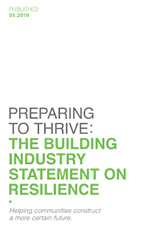American Institute of Architects and National Institute of Building Sciences officials, along with representatives of 38 design and construction industry organizations, have released “Preparing to Thrive: The Building Industry Statement on Resilience – Helping communities construct a more certain future,” a progress report surrounding a 2014 Resilience Building Coalition initiative.
The Coalition has also released a set of guiding principles to help the building industry adopt resilient design and policies. They include developing and advocating for codes and policies that advance resilience; advancing “whole-systems resilient design” approaches for the built environment; and, providing guidance, beyond baseline life-safety codes, that recognizes the importance of fortifying property for individual and community resilience. Since the charter Building Industry Statement on Resilience was unveiled, the Coalition has added 19 signatories. “Preparing to Thrive” includes results from a survey of how participants’ work has been impacted by the Statement:
- A majority of signatories have “become more aware of their unique role in achieving resilience,” spurring integration of related goals into organizational frameworks.
- Almost 30 percent of respondents have seen an increase in resilience as a priority within their organizations.
- More than two-thirds of respondents list high-performance buildings as an initiative they are most interested in advancing.
- More than half have used the Statement to “advance their organizational mission statement/values,” as well as “provide support and/or validation for moving forward on organization initiatives.”
- Respondents report more than 40 initiatives supporting the Statement’s resilience focus areas.
|
|
| The report examines Coalition activities under the headings of Prioritizing Resilience Across the Built Environment; Industry Statement on Resilience; Convening & Coalescing Around Community; Catalyzing Coordinated Goals & Response; Framework for Proactive Resilience (research, education, advocacy, response, planning); and, Future Endeavors. It can be viewed at www.aia.org. |
The report is an outgrowth of a May 2014 agreement through which industry leaders committed to promoting resilience in contemporary planning, building materials, design, construction and operational techniques as the solution for making the nation’s aging infrastructure more safe and secure.
“Resilient design places architects at the center of the solution, with particular emphasis on the private, non-governmental sectors,” affirms AIA CEO Robert Ivy. “I congratulate fellow leaders in the design and construction sector for joining together to make sure resiliency is not viewed as just a fad, but remains front and center in our efforts moving forward.”
Charter Coalition members include AIA, Associated Builders & Contractors, Associated General Contractors of America, International Code Council and National Association of Home Builders. Recent members and Statement signatories include Concrete Reinforcing Steel Institute, National Concrete Masonry Association, National Ready Mixed Concrete Association, and Portland Cement Association.
Along with the federal agency actions stemming from the early-May Conference on Resilient Building Codes (page 6), the White House cited actions among the private sector, including those of NCMA and CRSI, plus architectural, engineering and construction peer groups.
- NCMA commits to developing materials supporting a refined articulation of resilient construction as construction designed and built to survive foreseeable catastrophic events and continue near normal operation within a short recovery period.
- CRSI is launching a comprehensive education program this year, incorporating web-based tools and local learning resources to convey best practices for resilient design and construction.
- AGC commits to supporting a coordinated national strategy to invest in infrastructure and provide education and outreach on resiliency initiatives.
- AIA plans a curriculum for members’ professional development, encompassing resilient design and decision-making on hazard mitigation, plus community resilience.
- The Federal Alliance for Safe Homes is launching a national hurricane resilience initiative, #HurricaneStrong, through collaboration with FEMA, NOAA/National Weather Service, The Home Depot, and The Weather Channel.
- The International Code Council will co-lead an effort targeting a nationwide coalition to create and develop the country’s first Whole-Community metric for resilience.
- The Laborers’ International Union of North America aims to incorporate the latest knowledge to advance resilience and the implementation of building code provisions through its network of sites offering Department of Labor-approved apprenticeship programs.
- The National Institute of Building Sciences commits to convening industry stakeholders to develop recommendations to advance resilience and long-term performance in codes, standards and other policies.
- The Urban Land Institute plans a launch of a Returns on Resilience website, spotlighting design and development leaders in the real estate industry and highlighting the business case for resilient buildings.
- The U.S. Green Building Council commits to actively engaging through its partnership in Resilient Communities for America and additional efforts to promote resilient building codes.
CONSENSUS-DEFINED RESILIENCY
ASTM Committee E60 on Sustainability is drafting a proposed standard to help reach a consensus-driven, widely applicable definition of resiliency, and enable evaluation of that characteristic in products and materials. WK54254 will help business interests and consumers determine what materials and products are best suited, in terms of resiliency, for various applications. Primary users will be other standards developers looking to better define resiliency for their product types. Designers and consumers could also use the standard to inform environmentally-conscious and sustainable purchases.
“The topic of resiliency is becoming more discussed both in ASTM and outside by a variety of parties,” says E60 Chairman and Gypsum Association Director of Technical Services Michael Schmeida. “But there is not a definition of resiliency developed in a consensus manner, nor one that covers the concept at high level.”
In addition to the proposed standard, E60 plans an October 2017 symposium on the safety, resiliency and sustainability paradigm. Interested parties can contact Committee Vice Chair and symposium chair Emily Lorenz, [email protected]. E60 members invite participation of all stakeholders in sustainability measures, and are especially keen on expanding Subcommittee E60.07 on Water Use and Conservation; their next meeting is October 24-27 in Orlando. Contacts: technical, Michael Schmeida, 301/277-8742, [email protected]; staff liaison, Stephen Mawn, 610/832-9726, [email protected].
